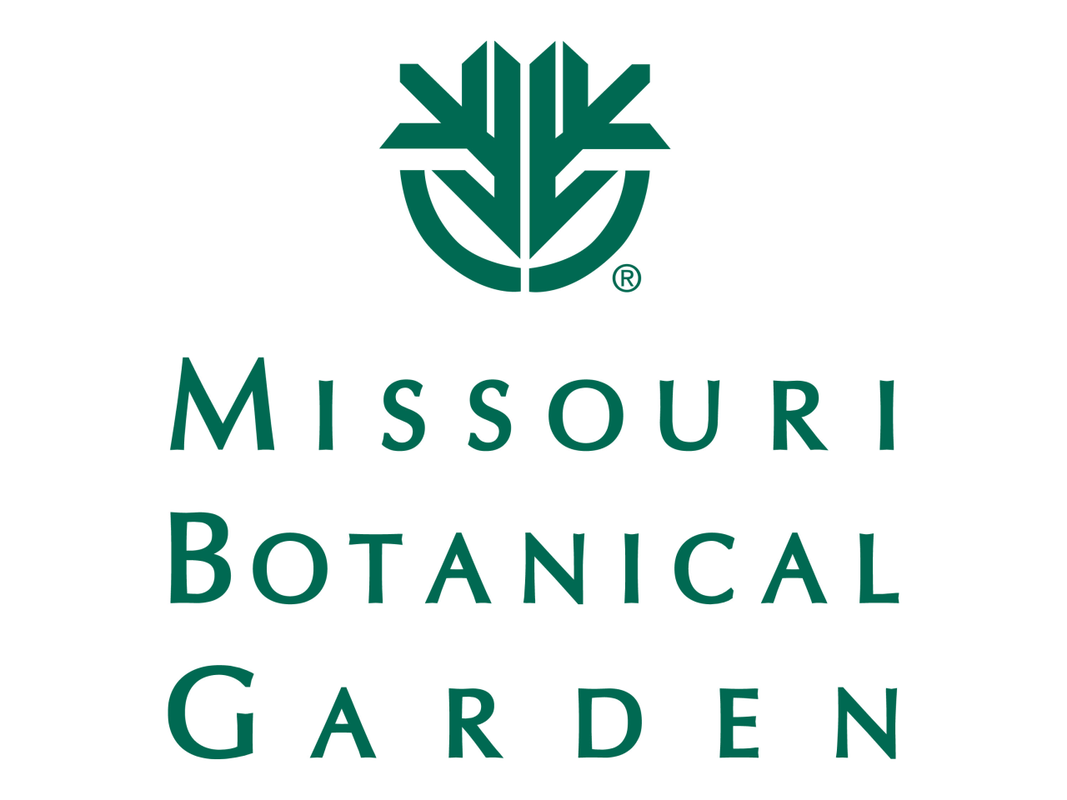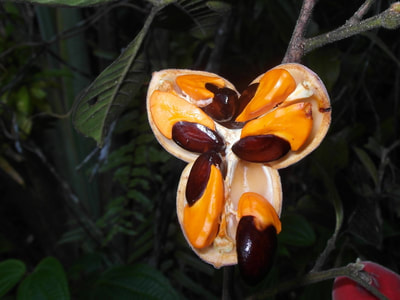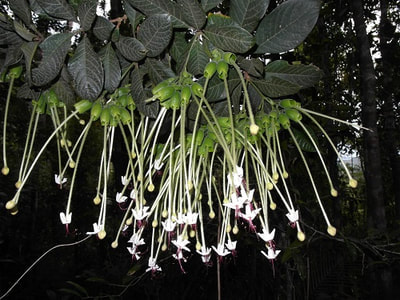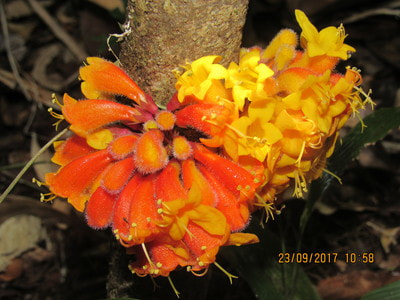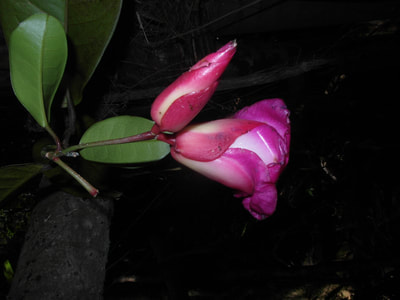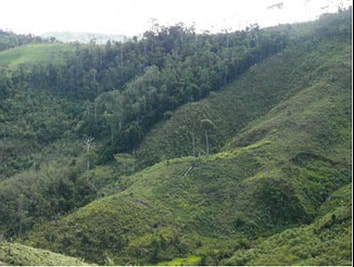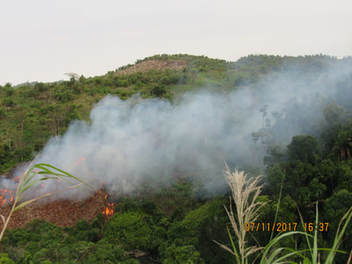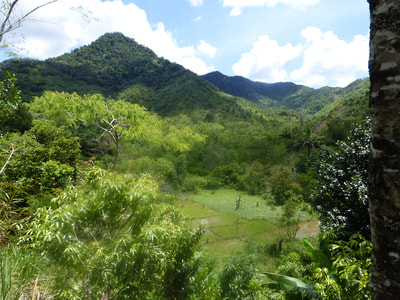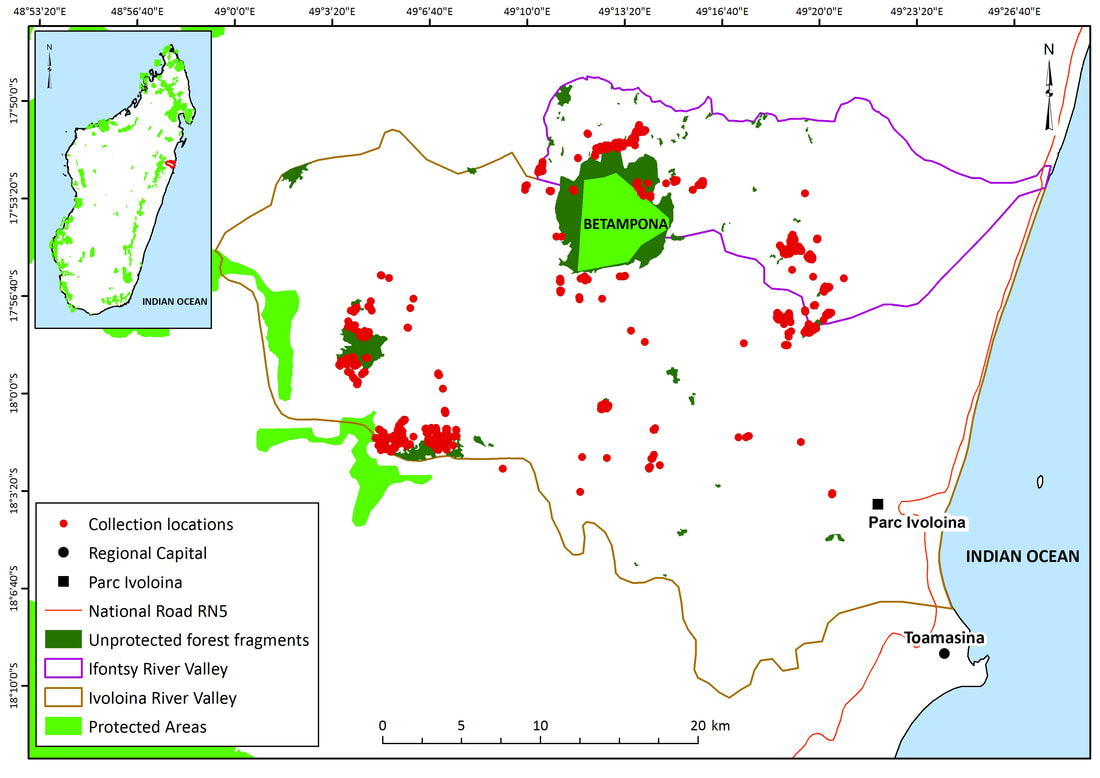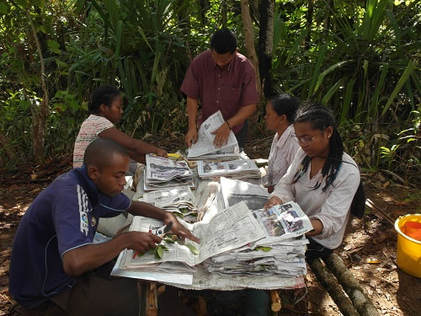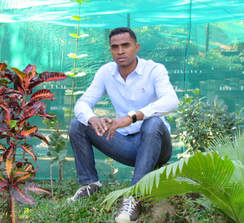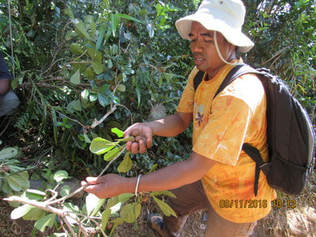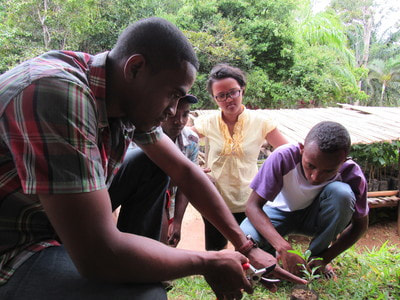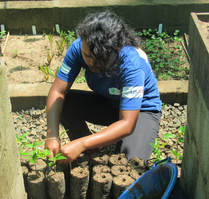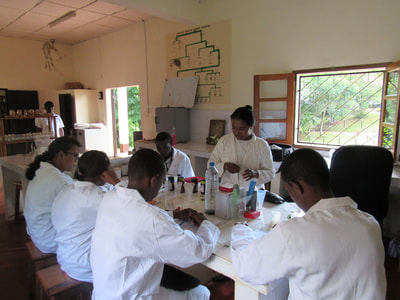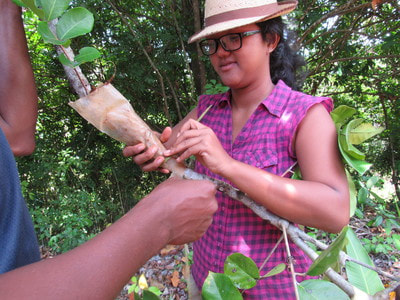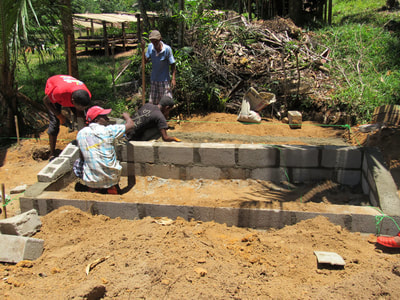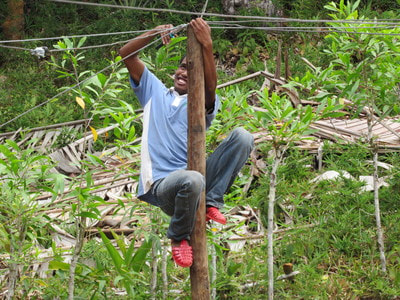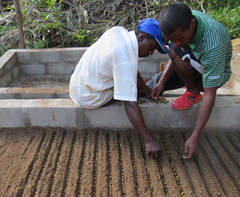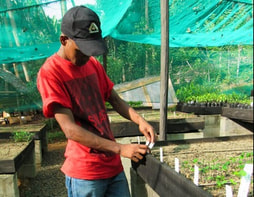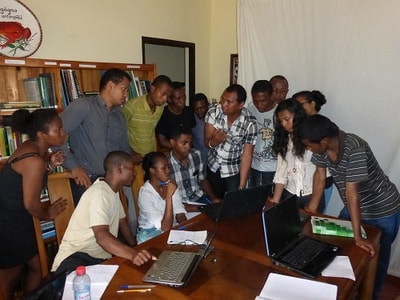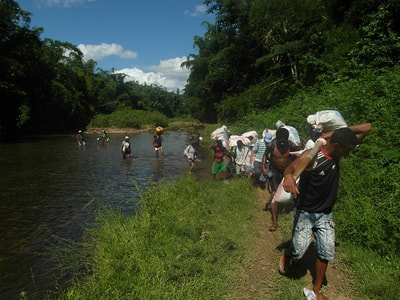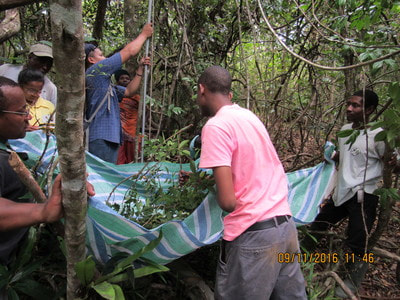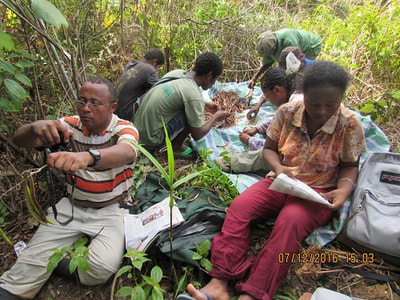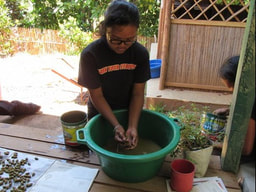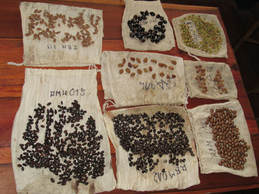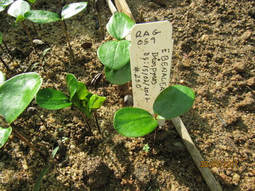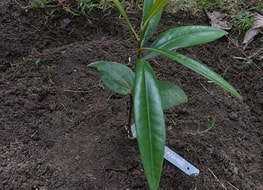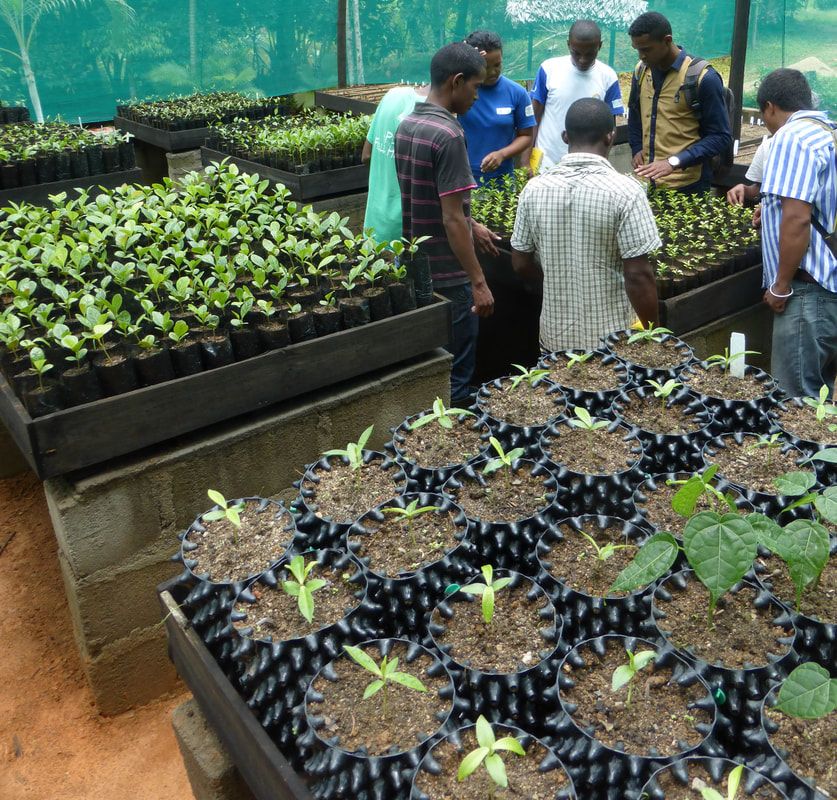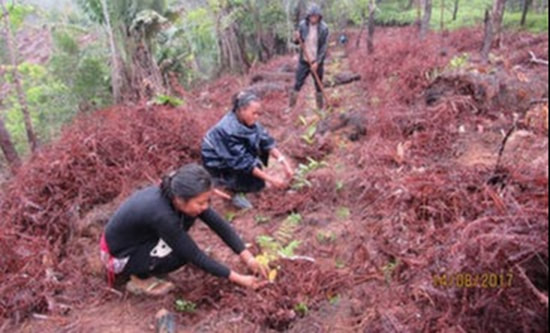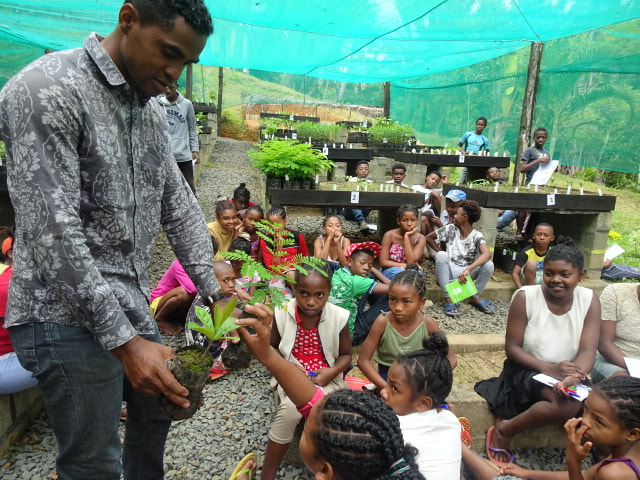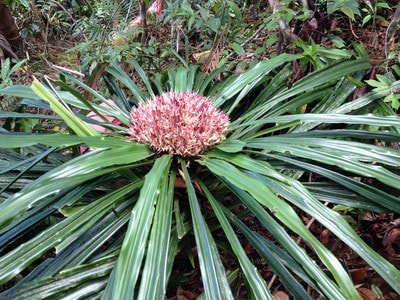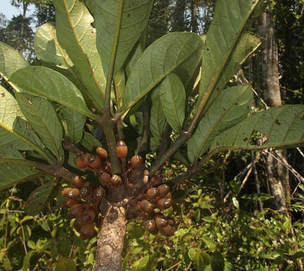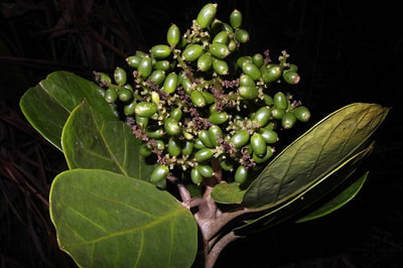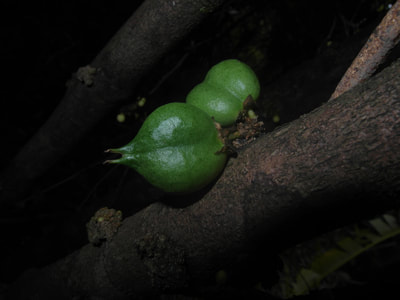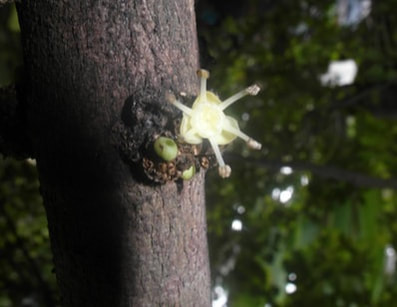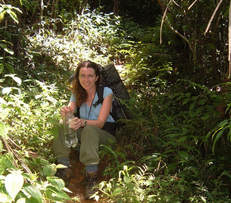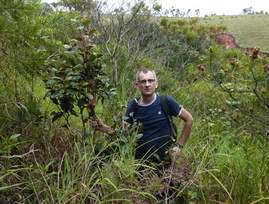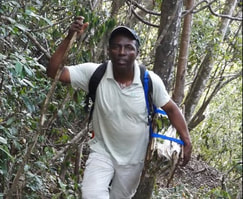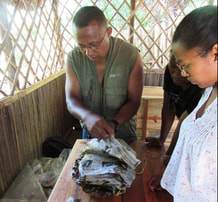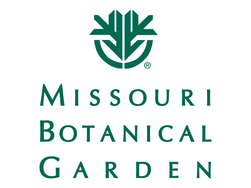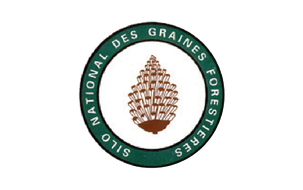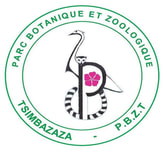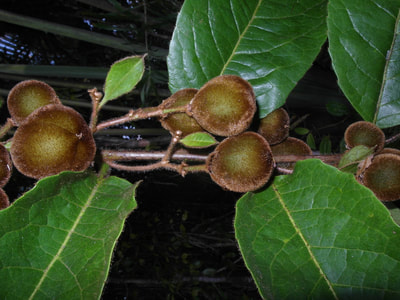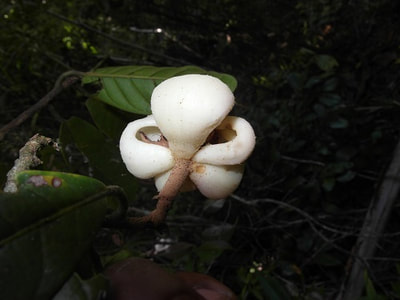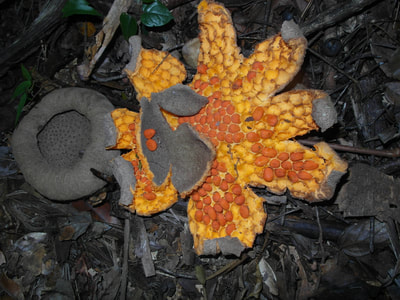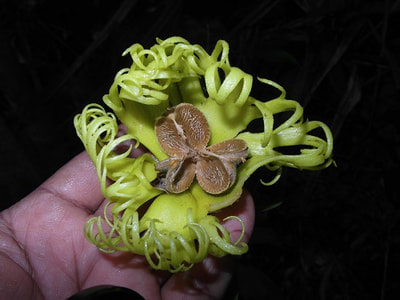The Darwin Initiative
Diverse agroforestry protects natural capital around Betampona and Vohibe, Madagascar

This 4-year project is the second Darwin Initiative-funded project that MFG has led (see below for details of the first). The project seeks to conserve the Betampona Strict Nature Reserve and the Vohibe Forest long term through the promotion and facilitation of more sustainable farming methods and the conservation of remaining forest fragments around the protected areas.
The Need for This Project
The current situation of predominant “slash and burn” or “tavy” agriculture in rural Madagascar is not sustainable and forest cover is being lost fast. Forest that supports a multitude of rare and unique species of plants and animals. But as conservationists we cannot simply ask people to stop the present techniques without providing help to embrace more sustainable methods such as agroforestry. Diverse production incorporating short-term cash crops in between a mixture of nitrogen-fixing, fruit, spice, timber and fuel wood trees reduces risks of crop failure for the farmers and allows a greater and more long-term production from smaller areas of land then the traditional monoculture rice-growing methods. Once valuable trees are planted, it reduces the risks of an area being burned and hence the risk of uncontrolled wildfires further impacting the protected areas and the biodiversity within. In addition, forest fragments around the periphery of the larger protected areas are important to maintain some level of forest connectivity for wildlife and are important refuges in an ever-degrading habitat. Local communities are similarly dependent on their remaining forest fragments for vital ecosystem services such as temperature control, water provision, forest products such as timber, fuelwood, medicinal plants and much more. This project works with local communities to help protect and monitor these vital forest fragments to ensure their survival in the long term and to try to reverse the present trend towards deforestation.
Project Locations
The project focusses on the long-term conservation of the two protected areas of Betampona Strict Nature Reserve and the Vohibe Forest (near Vatomandry). For Betampona we are partnering with the inspirational LOVASOA village association to also protect the significant 90 ha forest fragments of Ampasina, to the southeast of Betampona.
Vohibe Forest is a new 3,117 ha protected area managed by Missouri Botanical Garden and forms part of the Ankeniheny-Zahamena Forest Corridor. Both Vohibe and Betampona are sites of very high biodiversity with many unique and incredible species.
The Need for This Project
The current situation of predominant “slash and burn” or “tavy” agriculture in rural Madagascar is not sustainable and forest cover is being lost fast. Forest that supports a multitude of rare and unique species of plants and animals. But as conservationists we cannot simply ask people to stop the present techniques without providing help to embrace more sustainable methods such as agroforestry. Diverse production incorporating short-term cash crops in between a mixture of nitrogen-fixing, fruit, spice, timber and fuel wood trees reduces risks of crop failure for the farmers and allows a greater and more long-term production from smaller areas of land then the traditional monoculture rice-growing methods. Once valuable trees are planted, it reduces the risks of an area being burned and hence the risk of uncontrolled wildfires further impacting the protected areas and the biodiversity within. In addition, forest fragments around the periphery of the larger protected areas are important to maintain some level of forest connectivity for wildlife and are important refuges in an ever-degrading habitat. Local communities are similarly dependent on their remaining forest fragments for vital ecosystem services such as temperature control, water provision, forest products such as timber, fuelwood, medicinal plants and much more. This project works with local communities to help protect and monitor these vital forest fragments to ensure their survival in the long term and to try to reverse the present trend towards deforestation.
Project Locations
The project focusses on the long-term conservation of the two protected areas of Betampona Strict Nature Reserve and the Vohibe Forest (near Vatomandry). For Betampona we are partnering with the inspirational LOVASOA village association to also protect the significant 90 ha forest fragments of Ampasina, to the southeast of Betampona.
Vohibe Forest is a new 3,117 ha protected area managed by Missouri Botanical Garden and forms part of the Ankeniheny-Zahamena Forest Corridor. Both Vohibe and Betampona are sites of very high biodiversity with many unique and incredible species.
The amazing Association LOVASOA village community forest protection team!
Map showing location of Betampona, its surrounding forest fragments and the Ampasina forest fragments
Map Showing Location of the target village of Ampitabe in relation to Vohibe Protected Area (thin red outline) near Vatomandry, Eastern Madagascar
Project approach and activities
The project combines a variety of approaches to tackle the issue of long-term conservation of the two main target sites through:
• Reinforcement of local community legal commitments to sustainably manage the remaining forest fragments around the target protected areas.
• Facilitating regular quarterly patrols of the forest fragments by the local community village associations responsible for managing the forest fragments to monitor and deter illegal activities.
• Building capacity for the village associations to carry out quarterly ecological monitoring in the target forest fragments to gain a better understanding of the wildlife present and trends in their populations.
• Promoting forest restoration activities around the forest fragments to increase forest cover and connectivity.
• Reducing forest loss through the promotion of more sustainable farming methods such as agroforestry.
• Provision of training, start up materials and plants to enable the set-up of viable agroforestry plots for target participants, which we hope will start a cascade effect of promotion of agroforestry throughout the local communities surrounding our two target protected areas.
• Building local capacity for local communities to produce their own agroforestry trees through the set-up of “mother tree” orchards and training in propagation techniques such as grafting and air layering.
The project combines a variety of approaches to tackle the issue of long-term conservation of the two main target sites through:
• Reinforcement of local community legal commitments to sustainably manage the remaining forest fragments around the target protected areas.
• Facilitating regular quarterly patrols of the forest fragments by the local community village associations responsible for managing the forest fragments to monitor and deter illegal activities.
• Building capacity for the village associations to carry out quarterly ecological monitoring in the target forest fragments to gain a better understanding of the wildlife present and trends in their populations.
• Promoting forest restoration activities around the forest fragments to increase forest cover and connectivity.
• Reducing forest loss through the promotion of more sustainable farming methods such as agroforestry.
• Provision of training, start up materials and plants to enable the set-up of viable agroforestry plots for target participants, which we hope will start a cascade effect of promotion of agroforestry throughout the local communities surrounding our two target protected areas.
• Building local capacity for local communities to produce their own agroforestry trees through the set-up of “mother tree” orchards and training in propagation techniques such as grafting and air layering.
Project Partners
This project is implemented by a team that includes: The Madagascar Fauna and Flora Group (MFG), Missouri Botanical Garden (MBG), Association LOVASOA, the Kew Madagascar Conservation Centre, Prof Christof den Biggelaar (MFG’s ecoagriculture advisor), The Fruits, Vegetables, and Environmental Education (FVEE) Program of the Church of Jesus Christ in Madagascar (FJKM), Organe de Développement de Diocèse de Toamasina (ODDIT) and MC Ingredients.
This project is implemented by a team that includes: The Madagascar Fauna and Flora Group (MFG), Missouri Botanical Garden (MBG), Association LOVASOA, the Kew Madagascar Conservation Centre, Prof Christof den Biggelaar (MFG’s ecoagriculture advisor), The Fruits, Vegetables, and Environmental Education (FVEE) Program of the Church of Jesus Christ in Madagascar (FJKM), Organe de Développement de Diocèse de Toamasina (ODDIT) and MC Ingredients.
Progress Tracker
The Darwin Initiative
The Darwin Initiative is a UK government grants scheme that helps conserve biodiversity and support the communities that live alongside it through locally led projects worldwide. More information about the Darwin Initiative can be found at their website: http://www.darwininitiative.org.uk/
The Darwin Initiative is a UK government grants scheme that helps conserve biodiversity and support the communities that live alongside it through locally led projects worldwide. More information about the Darwin Initiative can be found at their website: http://www.darwininitiative.org.uk/
Ex-situ Conservation of Threatened Plants from the Ivoloina-Ifontsy Valleys
This 3-year project trains young Malagasy botanists and conservation horticulturalists and then directs and coaches them to prevent the loss, through ex-situ conservation, of sub-populations of at least 500 species of flowering plants growing in doomed forest fragments in the Ivoloina-Ifontsy River Valleys in central-eastern Madagascar.
From left to right: Trichilia muronata, Clerodendrum trichanthum, Vitex cauliflora and Rhodolaena coriacea
The Need for This Project
The Malagasy flora is both exceptionally rich (14,000 species) and highly endemic (90%). However, it is also very threatened by anthropogenic activities (e.g. shifting cultivation, wild fires, charcoal production etc.). Between 1950 and 2000, 40% of remaining forest was destroyed and forest loss continues today at a similar pace. Most forest outside of protected areas will be lost in the next decade. An estimated 14% of the native Malagasy flora is not included in any protected area and many of these excluded species occur as tiny populations in small, degraded fragments of natural vegetation where they are exceptionally vulnerable. Ideally, these habitats should be conserved but this rarely occurs because of their small size and degraded nature. Thus, the most viable alternative to extinction for these species will be ex-situ conservation, either as growing plants in secure collections or as seeds in seed banks. In this project we focus on the ex-situ conservation of plants growing in unprotected forest fragments in the Ivoloina and Ifontsy river valleys of central-eastern Madagascar.
The Malagasy flora is both exceptionally rich (14,000 species) and highly endemic (90%). However, it is also very threatened by anthropogenic activities (e.g. shifting cultivation, wild fires, charcoal production etc.). Between 1950 and 2000, 40% of remaining forest was destroyed and forest loss continues today at a similar pace. Most forest outside of protected areas will be lost in the next decade. An estimated 14% of the native Malagasy flora is not included in any protected area and many of these excluded species occur as tiny populations in small, degraded fragments of natural vegetation where they are exceptionally vulnerable. Ideally, these habitats should be conserved but this rarely occurs because of their small size and degraded nature. Thus, the most viable alternative to extinction for these species will be ex-situ conservation, either as growing plants in secure collections or as seeds in seed banks. In this project we focus on the ex-situ conservation of plants growing in unprotected forest fragments in the Ivoloina and Ifontsy river valleys of central-eastern Madagascar.
Two examples of small and disappearing forest patches from which the Darwin Initiative team collected seeds and, on the left, completely surrounded by a human landscape, is Betampona Natural Reserve, a lowland rainforest that harbors high levels of biodiversity.
|
Project Location
In the recent past the landscape of the Ivoloina and Ifontsy river valleys would have been covered by continuous lowland rainforest. Now little of this forest remains: just the 22 km² Betampona Natural Reserve and a scatter of tiny, degraded, unprotected and very threatened fragments in the surrounding landscape. In this project we aim to collect seed samples from native plants surviving in these unprotected fragments and conserve this biodiversity as growing plants at Parc Ivoloina or as seeds in seed banks. Parc Ivoloina was originally established by the French to identify non-native commercial trees that could thrive in Madagascar’s east coast environment. Today Parc Ivoloina is managed under lease by the MFG. Its 282 hectares comprise a matrix of habitat patches that are still dominated by exotic trees but are purposefully being replaced with east coast endemic species. |
Project approach and activities
This project seeks not just the ex-situ conservation of threatened Malagasy plants but also aims to train a select group of motivated young Malagasy men and women to gain the additional skills required to become botanists and conservation horticulturalists. The majority of the training was explicitly intended to be in the form of hands-on experience under the tutelage and supervision of seasoned professionals. The major elements in this project are:
This project seeks not just the ex-situ conservation of threatened Malagasy plants but also aims to train a select group of motivated young Malagasy men and women to gain the additional skills required to become botanists and conservation horticulturalists. The majority of the training was explicitly intended to be in the form of hands-on experience under the tutelage and supervision of seasoned professionals. The major elements in this project are:
|
Training four young Malagasy to become excellent field botanists
Vouchered seed samples of plants growing in doomed forest fragments of the Ivoloina and Ifontsy river valleys are being collected by four young Malagasy botanists who were trained by the project and are being coached during their work. Training was provided over 3 months by an array of experts from diverse organisations including: Missouri Botanical Garden, Royal Botanic Gardens Kew, Parc Botanique et Zoologique de Tsimbazaza and Silo National des Graines Forestières (SNGF). Major themes included in the training were: plant identification, leadership, organisation of safe, effective and ethical field trips, collection of voucher herbarium specimens, and collection of high quality seed samples for ex-situ conservation. A special thanks to Richard Randrianaivo, and Solofo Rakotarisoa for sharing their expertise and to Patrice Antilahimena, one of Madagascar’s most experienced field botanists, who will continue to mentor the young botanists as they conduct their work. |
|
Training of six young Malagasy as conservation horticulturists
In Madagascar the propagation of plants is typically treated as an unskilled occupation but in this project we propose the opposite to be true and we have invested in training five young Malagasy over 2 months in the full array of horticultural skills. The training was led by Alex Mamisoa (right), a passionate and experienced horticulturalist, with important contributions from Lala Randriatavy (far right) and staff from SNGF. It is these trainees, with the ongoing coaching from Alex, who are propagating the seed samples collected by the field botanists. |
Creation of a Model Nursery
To propagate the hundreds of seed samples collected by the field botanists the existing nursery was rehabilitated and a large new nursery was installed at Parc Ivoloina. Following best practice, these nurseries included a series of propagation tables (so that seedlings are not at ground level where they are more vulnerable to attack by pests), clean graveled paths and shade netting roof and walls.
To propagate the hundreds of seed samples collected by the field botanists the existing nursery was rehabilitated and a large new nursery was installed at Parc Ivoloina. Following best practice, these nurseries included a series of propagation tables (so that seedlings are not at ground level where they are more vulnerable to attack by pests), clean graveled paths and shade netting roof and walls.
Field Trips to Collect Vouchered Seed Samples from Doomed Forests
After their training, the field botanists, with coaching from Patrice, began to organise a series of fieldtrips to systematically visit remaining unprotected forest fragments in the Ivoloina and Ifontsy river valleys. When the botanists encounter native plants with ripe seeds they collect seed samples. Each sample is accompanied by a voucher herbarium specimen to enable scientific identification and, where possible, the seeds in the sample were collected from several individuals of the same species to maximise the genetic diversity of the sample.
After their training, the field botanists, with coaching from Patrice, began to organise a series of fieldtrips to systematically visit remaining unprotected forest fragments in the Ivoloina and Ifontsy river valleys. When the botanists encounter native plants with ripe seeds they collect seed samples. Each sample is accompanied by a voucher herbarium specimen to enable scientific identification and, where possible, the seeds in the sample were collected from several individuals of the same species to maximise the genetic diversity of the sample.
Propagation of Seed Samples and Seed Banking
Each seed sample, tagged with the number of its voucher, is sent to the nursery team at Parc Ivoloina, who accession, clean and sow the seeds. As the seeds germinate the seedlings are pricked out into pots and grown on until large enough to be planted.Throughout the process the plants are carefully tagged with their accession number. A proportion of seed samples from species judged to be suitable for preservation in seed banks are dispatched to SNGF for inclusion in their seed bank. A subset of these seeds are then forwarded to Royal Botanic Gardens, Kew for inclusion in their Millennium Seedbank.
Each seed sample, tagged with the number of its voucher, is sent to the nursery team at Parc Ivoloina, who accession, clean and sow the seeds. As the seeds germinate the seedlings are pricked out into pots and grown on until large enough to be planted.Throughout the process the plants are carefully tagged with their accession number. A proportion of seed samples from species judged to be suitable for preservation in seed banks are dispatched to SNGF for inclusion in their seed bank. A subset of these seeds are then forwarded to Royal Botanic Gardens, Kew for inclusion in their Millennium Seedbank.
Planting the Accessions
Once the seedlings have attained 35 cm in height, they are individually labelled with an aluminium tag and planted out into a part of Parc Ivoloina that has been designated as the location of the ex-situ conservation collection for plants. The planting location of each seedling is georeferenced and this information is captured in the accession database. These plants will be weeded and shaded and watered if necessary until well established and monitored every 12 months to track survival and growth.
Once the seedlings have attained 35 cm in height, they are individually labelled with an aluminium tag and planted out into a part of Parc Ivoloina that has been designated as the location of the ex-situ conservation collection for plants. The planting location of each seedling is georeferenced and this information is captured in the accession database. These plants will be weeded and shaded and watered if necessary until well established and monitored every 12 months to track survival and growth.
Progress Tracker
Click below for:
Accession Database : Ex-situ Conservation of Threatened Plants from the Ivoloina-Ifontsy Valleys
| |||||||||||||||||||||||||||||||||||
From Left to Right: Dracaena umbraculifera, New species of Vitex, New species of Melanophylla
New Species - And Possibly New Genus
The below unusual plant was discovered in a small forest fragment near Betampona Natural Reserve. A new, yet-to-be-named species within the family Celastraceae, botanists believe it may be an entirely new genus.
The below unusual plant was discovered in a small forest fragment near Betampona Natural Reserve. A new, yet-to-be-named species within the family Celastraceae, botanists believe it may be an entirely new genus.
Highlight achievements (as of June 2019)
- The model nursery with its skilled staff is now being solicited by other organisations to provide training for their staff in best practices for the propagation of native trees – to date 106 people have been trained in this manner.
- Among the forest fragments visited by the field botanists was a cluster of fragments known as the Ampasina Forest. Here we were surprised to discover a community association, called VOI-Lovasoa, dedicated to conserving these forest vestiges. Our work at this site provided information on the flora of their forest that the association can use for fund-raising and to guide management, provided some income for association members who worked with us as guides and seed collectors, and helped convince doubters in the community that the forest was truly important.
- Six species of plants have been discovered that are thought to be new to science: a species of Melanophylla (Toricelliaceae), two species of Polyscias (Araliaceae) and a species of Vitex (Lamiaceae), a species of Celastraceae (perhaps a new genus), and a species of Rhopalocarpus (Sphaerosepalaceae).
- Several sub-populations of Dracaena umbraculifera has been discovered. This dramatic and critically endangered plant was thought until recently to be extinct in the wild.
- 43 of the species planted in Parc Ivoloina have been labelled with trilingual educational signs.
- To date 1,169 students have visited the nursery – and many have participated in nursery work or in planting out the young plants
|
The Darwin Initiative
The Darwin Initiative is a UK Government funding program that aims to assist countries with rich biodiversity but poor financial resources to meet their objectives under various biodiversity-related conventions including the Convention on Biological Diversity (CBD). More information about the Darwin Initiative can be found at their website: http://www.darwininitiative.org.uk/ |
Project partners
This project is implemented by a team that includes: The Madagascar Fauna and Flora Group (MFG), Missouri Botanical Garden (MBG), Silo National des Graines Forestières (SNGF), the Royal Botanic Gardens Kew; and Parc Botanique et Zoologique de Tsimbazaza (PBZT).
This project is implemented by a team that includes: The Madagascar Fauna and Flora Group (MFG), Missouri Botanical Garden (MBG), Silo National des Graines Forestières (SNGF), the Royal Botanic Gardens Kew; and Parc Botanique et Zoologique de Tsimbazaza (PBZT).
Project managers and trainers: Karen Freeman, Chris Birkinshaw, Richard Randrianaivo and Patrice Antilahimema
|
Missouri Botanical Garden (MBG), a managing member of MFG, has been an important, long term advisor and conservation partner. MBG has been working in Madagascar since the 1970’s and have built a diverse program of scientific research (responsible for the discovery of multiple new species and many taxonomic revisions of Madagascar’s flora) and have more recently developed a comprehensive conservation program including both in-situ and ex-situ projects. Dr Chris Birkinshaw, MBG’s Technical Advisor, has been the mastermind of this Darwin Initiative project and has advised on all technical aspects of the project. Richard Randrianaivo and Patrice Antilahimena have led the botanical training and field work aspects of the project.
|
|
Royal Botanic Gardens, Kew began working in Madagascar in 1986 and have made a large contribution to knowledge of the Malagasy flora including producing several important reference publications. Kew actively participate in a range of conservation activities including ex-situ conservation of endangered species and several development initiatives valorising important native Malagasy plants (such as highly nutritional endemic yams). Stuart Cable, Kew’s Madagascar Research Leader, was involved in the conception and set up of the Darwin Initiative project and Solofo Rakotoarisoa, Kew’s Ecosystems Team Leader in Madagascar, has been instrumental in training the field botanists, helping with the first year’s field collection trips, providing taxonomic advice and facilitating the export of a sub-set of suitable seeds collected through this project seeds to Kew’s Millennium Seedbank for ex-situ preservation.
|
|
Silo National des Graines Forestières (SNGF) work to valorise Malagasy flora as a commercial enterprise providing seed for multiple reforestation and restoration initiatives across Madagascar. They carry out important research on the propagation of certain commercially important species and play a vital role nationally in ex-situ plant conservation by housing their own seedbank and exporting seed to Kew’s Millennium Seedbank. In this Darwin Initiative Project SNGF have been responsible for helping train both field botanists and horticulturalists, participating in field collection trips, conserving suitable seed within their own seedbank and preparing batches for export to Kew.
|
|
Parc Botanique et Zoologique de Tsimbazaza (PBZT), located in the capital, Antananarivo, was founded in 1925. As well as being an attraction for national and international visitors, PBZT is involved in multiple research projects and ex-situ conservation efforts. In this project PBZT have helped train the botanical team, participated in field collection trips and are keeping representatives of a large proportion of the species collected through this project in their ex-situ collection.
|
From left to right: Paropsia madagascariensis, Eremolaena humblotiana, Tambourissa uapacifolia, and an unknown species of Schizolaena.
Contacts
For more information about this Darwin Initiative Project please contact the Project Leader, Dr. Karen Freeman: karen(AT)savethelemur(DOT)org
For more information about this Darwin Initiative Project please contact the Project Leader, Dr. Karen Freeman: karen(AT)savethelemur(DOT)org
















